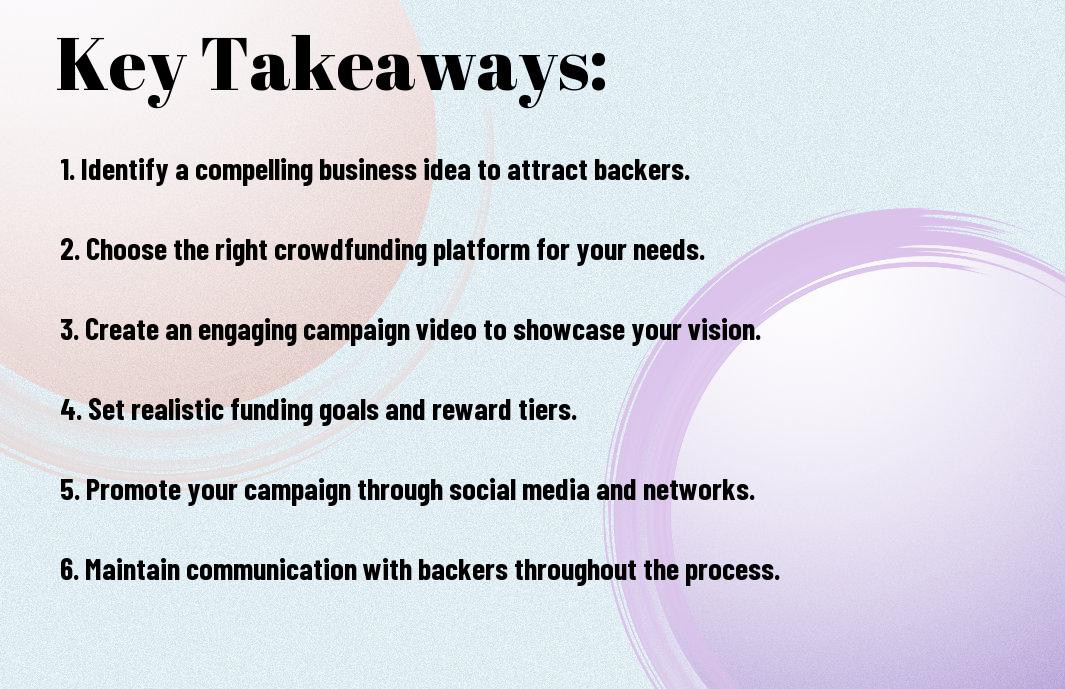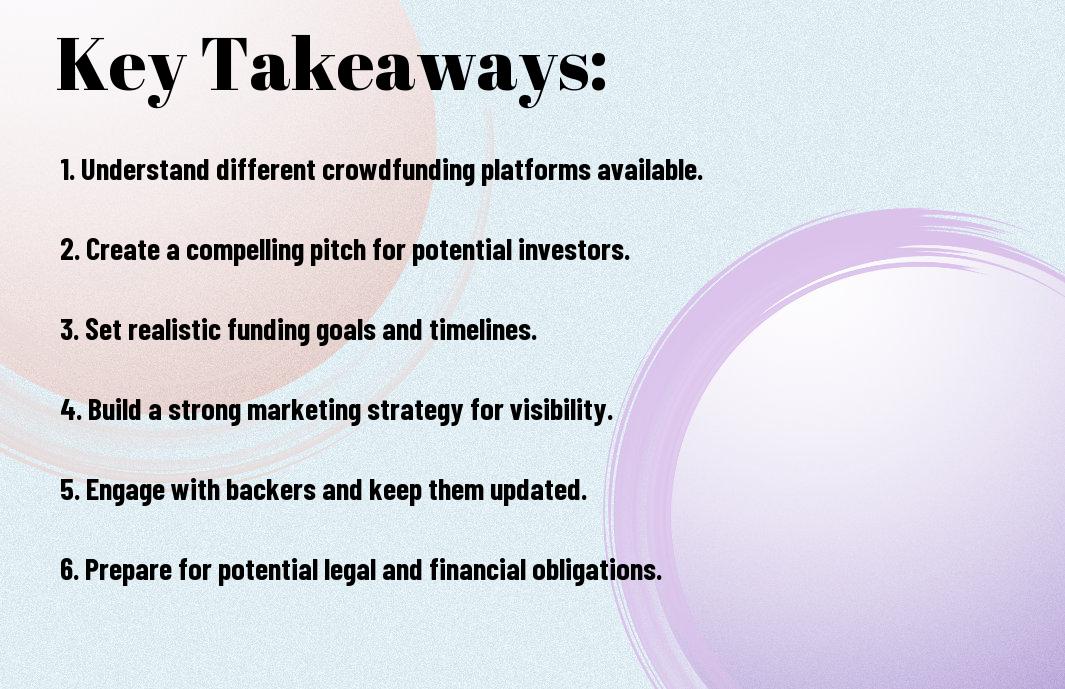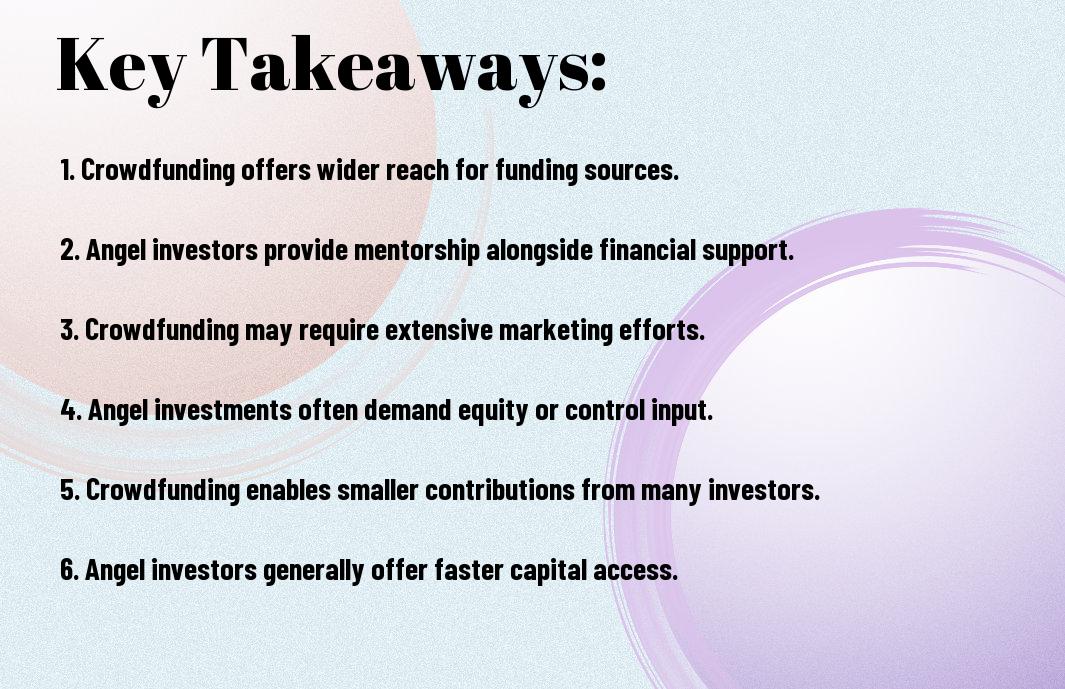Financing your business can be a daunting task, but crowdfunding offers an innovative solution that empowers you to access capital directly from supporters. By harnessing the collective power of the crowd, you can not only secure funds but also build a community around your brand. This guide will walk you through the steps to effectively utilize crowdfunding, allowing you to engage potential backers and turn your entrepreneurial dreams into reality.
Key Takeaways:
- Define Your Goals: Clearly outline the amount of funding needed and specific objectives to increase transparency and attract backers.
- Choose the Right Platform: Research and select a crowdfunding platform that aligns with your business model and target audience to maximize visibility.
- Create Engaging Content: Develop a compelling pitch, including videos and images, to connect with potential backers and convey your business vision.
- Build a Community: Engage with supporters before launching to create a loyal base that can help spread the word and contribute during the campaign.
- Plan for Fulfillment: Prepare a strategy for delivering rewards to backers promptly to maintain trust and encourage future support.

Understanding Crowdfunding
While traditional funding methods may limit your options, crowdfunding offers a dynamic avenue for financing your business ideas. It empowers you to reach out to a wide audience, allowing you to showcase your concept and gather support from potential investors and customers. This approach not only helps you obtain funds but also validates your business ideas through community engagement.
Definition and Types of Crowdfunding
Crowdfunding is a method of raising capital through the collective effort of individuals, typically via online platforms. Various types of crowdfunding exist, each catering to different needs:
- Donation-based crowdfunding
- Rewards-based crowdfunding
- Equity crowdfunding
- Debt crowdfunding
- Real estate crowdfunding
The right type for your business depends on your goals and the structure of your project.
| Type | Description |
| Donation-based | Contributors give without expecting anything in return. |
| Rewards-based | Backers receive non-monetary rewards for their support. |
| Equity | Investors receive shares in your business. |
| Debt | Funds are raised as a loan that must be repaid. |
| Real Estate | Investments are made in property ventures. |
Advantages and Disadvantages
Beside providing you with necessary capital, crowdfunding can also enhance your brand visibility and create a loyal customer base. However, it isn’t without challenges, as you may face competition and the need to continuously market your campaign to achieve your funding goals.
Hence, weighing the advantages against the disadvantages is important before you start your crowdfunding journey. By understanding the potential benefits, like increased exposure and access to a broad audience, alongside the possible downsides, such as time investment and the risk of not meeting your funding targets, you can develop a solid strategy tailored to your business aspirations. This will enable you to navigate your crowdfunding campaign with confidence and clarity.
Preparing Your Business for Crowdfunding
Now that you’ve decided to consider crowdfunding, it’s time to prepare your business for this unique funding opportunity. This preparation involves refining your business idea, creating a solid plan, and understanding the landscape of crowdfunding. By taking the time to organize your thoughts and strategies, you can greatly increase your chances of successfully reaching your funding goal and building a supportive community around your brand.
Crafting a Compelling Business Plan
About crafting your business plan, it should clearly outline your business model, goals, and the impact of your product or service. Include financial projections, marketing strategies, and your unique selling proposition. A well-structured plan acts as a roadmap for your campaign and demonstrates to potential backers that you’ve thought through every aspect of your business.
Identifying Your Target Audience
For your crowdfunding campaign to succeed, you need to identify your target audience. This will help you tailor your messaging and strategies to attract supporters who genuinely connect with your vision and offerings.
Identifying your target audience involves researching demographics such as age, interests, and purchasing behavior. Consider creating detailed buyer personas that encapsulate your ideal backers. By understanding who they are and what they care about, you can design targeted campaigns and communications that resonate with them, increasing the likelihood of conversions during your crowdfunding effort.
Choosing the Right Crowdfunding Platform
All crowdfunding platforms are not created equal, and selecting the right one for your business is pivotal. You’ll want to consider the type of crowdfunding that aligns with your goals, whether it’s rewards-based, equity-based, or donation-based. Each platform has its unique audience and fee structure, so researching your options thoroughly will ensure you select the one that best supports your vision and maximizes your chances of success.
Popular Crowdfunding Platforms
Before plunging into your crowdfunding campaign, explore some of the popular platforms available: Kickstarter, Indiegogo, GoFundMe, and SeedInvest are among the most recognized. Each has its strengths and appeals to different niches, so it’s crucial to evaluate which one aligns with your business needs and target audience.
Factors to Consider
Along with popularity, there are several factors to consider when selecting your crowdfunding platform:
- Fee structure and associated costs
- Target audience demographics
- Funding model (fixed vs. flexible)
- Platform reputation and credibility
- Available marketing tools and support
Assume that a carefully chosen platform can significantly enhance your fundraising potential and overall campaign experience.
Consider these factors more closely as they can impact your crowdfunding success. Assess the fee structures because high costs can eat into your funds. Look into the demographic of the platform’s audience to ensure they match your target base. Analyze which funding models best suit your project; a fixed goal may motivate supporters differently than flexible options. Evaluate the platform’s credibility and reputation, as trustworthy platforms attract more backers. Lastly, explore any marketing tools or support they offer to help amplify your reach.
- Fee structures and potential hidden costs
- Audience compatibility with your business niche
- Fundraising goals and platform flexibility
- Trustworthiness of the platform within the crowdfunding community
- Support for marketing and promoting your project
Assume that the right considerations will lead to heightened awareness and funding opportunities for your campaign.

Creating a Successful Campaign
Your success in crowdfunding hinges on how well you craft your campaign. This means presenting a compelling story that resonates with potential backers, showcasing your vision clearly, and building an engaging narrative around your brand. High-quality visuals, including videos and images, can elevate your campaign and attract more supporters. Additionally, maintaining transparent communication throughout the process will help foster trust and reinforce your relationship with backers.
Setting Funding Goals and Rewards
Between defining your financial needs and setting achievable milestones, it’s crucial to establish clear funding goals. Determine how much money you need to launch or expand your business, and break this down into manageable targets. Additionally, offering enticing rewards will encourage backers to contribute, so consider tiered incentives that provide meaningful value for different levels of support.
Marketing Your Campaign
Setting a strong marketing strategy is vital for your campaign’s visibility and success. Utilize social media, email marketing, and online communities to spread the word about your crowdfunding effort and build a buzz around your project.
Plus, engaging storytelling through regular updates and behind-the-scenes content can keep your audience invested in your journey. Leverage influencers and partnerships to amplify your reach; this can introduce your campaign to potential backers beyond your immediate circle. Build an email list beforehand and create a sense of urgency with limited-time offers or countdowns. All these tactics will help generate the attention and support you need to reach your funding goals.
Engaging with Backers
Not all crowdfunding campaigns succeed because of the product alone; engaging with your backers is necessary. You must keep them informed and invested in your journey. Frequent updates and personalized responses can foster a sense of belonging and commitment among your supporters, making them your advocates and ambassadors.
Communication Strategies
On building effective communication strategies, it’s imperative to establish a consistent posting schedule and utilize various platforms. Regular updates through emails, social media, and project updates can help maintain interest and keep backers informed. Addressing queries promptly shows that you value their input, enhancing their overall experience.
Building a Community
Communication plays a vital role in building a community around your project. By encouraging open dialogue and interaction, you create an environment where backers feel valued. Their feedback can be instrumental in refining your project, while they gain a sense of ownership and pride in your success.
In fact, fostering a community can lead to long-term relationships with your backers. You can create forums, organize Q&A sessions, or even involve them in decision-making processes to enhance their engagement. Community-driven projects often see increased loyalty and support because backers are more than just funders; they become invested partners in your venture.
Post-Campaign Strategies
Unlike many entrepreneurs expect, your responsibility doesn’t stop once the campaign ends. In fact, effective post-campaign strategies are necessary to ensure smooth execution of your project and to capitalize on the momentum you’ve built up during the campaign. Establishing a clear plan for fulfilling rewards, communicating with backers, and harnessing social proof can set you up for long-term success.
Fulfillment of Rewards
PostCampaign, it’s time to deliver the rewards you promised to your backers. This process requires meticulous planning and organization to ensure that everything arrives on time and as expected. Keep your backers updated on the status of their rewards and resolve any issues swiftly to maintain trust.
Maintaining Relationships with Backers
Backers are your most valuable asset after a crowdfunding campaign, so nurturing these relationships can foster loyalty and encourage future support. Engage regularly with your backers through updates, newsletters, and social media, keeping them informed about your business’s progress and upcoming projects.
But don’t just communicate out of obligation; genuinely involve your backers in your journey. Share behind-the-scenes content, ask for their feedback on new ideas, and celebrate milestones together. By making them feel like part of your team, you create a community that is more likely to support your future endeavors and spread the word about your brand.
Final Words
Considering all points, using crowdfunding to fund your business can be an effective strategy that allows you to engage with potential customers while raising capital. It’s important to create a compelling pitch, utilize the right platforms, and market your campaign effectively to attract backers. By planning thoroughly and connecting with your audience, you can increase your chances of success. For more insights on funding your business, check out the Fund your business | U.S. Small Business Administration.
FAQ
Q: What types of crowdfunding are available for business funding?
A: There are several types of crowdfunding available for businesses, including donation-based, rewards-based, equity-based, and debt-based crowdfunding. Donation-based crowdfunding allows backers to contribute without expecting financial returns, while rewards-based crowdfunding offers incentives such as products or services in exchange for contributions. Equity-based crowdfunding lets backers invest in exchange for ownership shares of the business, and debt-based crowdfunding involves raising funds as loans that must be repaid with interest. Each type has its own benefits and is suited for different types of business projects.
Q: How can a business effectively promote its crowdfunding campaign?
A: To promote a crowdfunding campaign effectively, businesses should utilize multiple channels to reach their target audience. This includes leveraging social media platforms, creating engaging content such as videos and blog posts, and networking within relevant communities. Initial outreach to friends, family, and existing customers can generate early momentum. Additionally, employing email marketing to keep potential backers updated and collaborating with influencers or bloggers in the industry can help to expand the reach. It is also important to communicate a compelling story that resonates with supporters.
Q: What are the common mistakes to avoid when using crowdfunding for business funding?
A: Common mistakes when using crowdfunding include setting unrealistic funding goals, failing to plan an effective marketing strategy, and not clearly defining the project or business value proposition. Additionally, neglecting to engage with backers and provide updates throughout the campaign can deter future support. Another error is not being transparent about potential risks, which can lead to trust issues. Properly researching successful campaigns and asking for feedback during the preparation phase can help avoid these pitfalls and contribute to a successful fundraising effort.




